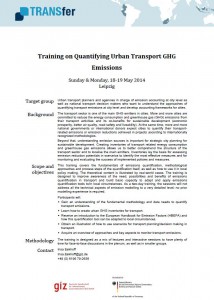Training on Quantifying Urban Transport GHG Emissions
 How to quantify urban transport GHG emissions is the leading question of the upcoming training of the TRANSfer project in Leipzig from 18-19 May 2014. As the transport sector is one of the main GHG emitters in cities, urban transport planners and decision makers might have an interest in building mitigation strategies and quantify these. Particularly the co-benefits, such as economic prosperity, better air quality, road safety and livability are reasons for more sustainable transport.
How to quantify urban transport GHG emissions is the leading question of the upcoming training of the TRANSfer project in Leipzig from 18-19 May 2014. As the transport sector is one of the main GHG emitters in cities, urban transport planners and decision makers might have an interest in building mitigation strategies and quantify these. Particularly the co-benefits, such as economic prosperity, better air quality, road safety and livability are reasons for more sustainable transport.
Creating inventories of transport related energy consumption and greenhouse gas emissions allows us to better comprehend the structure of the transport sector and to localise the main emitters. The TRANSfer Project is holding the training on “Quantifying Urban Transport GHG Emissions” at 18-19 May 2014 in Leipzip.
This training covers the fundamentals of emissions quantification, methodological approaches and process steps of the quantification itself, as well as how to use it in local policy making. The theoretical content is illustrated by real-world cases. The training is designed to improve awareness of the need, possibilities and benefits of emissions quantification in transport and build basic capacity to adapt and apply emissions quantification tools to/in local circumstances. As a two-day training, the sessions will not address all the technical aspects of emission modelling to a very detailed level; no prior modelling experience is required.
Participants will:
- Gain an understanding of the fundamental methodology and data needs to quantify transport emissions.
- Learn how to create urban GHG inventories for transport.
- Receive an introduction to the European Handbook for Emission Factors (HBEFA) and how this quantification tool can be adapted to local circumstances.
- Obtain an illustration of how to use scenarios for transport planning/decision making in transport.
- Acquire an overview of approaches and key aspects to monitor transport emissions.
The training is designed as a mix of lectures and interactive sessions to have plenty of time for face-to-face discussions in the plenum, as well as in smaller groups.Please find the presentations and exercise here.
